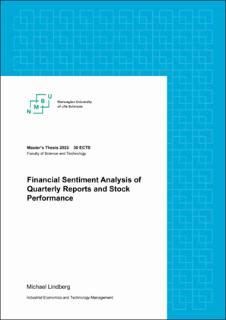| dc.description.abstract | This thesis aims to examine the use of financial sentiment analysis for quarterly reports published by companies listed on the Oslo Stock Exchange (OSE). Additionally, the intention of the study is to use methods from computer science to enable the transformation of financial reports, from the raw PDF format to the financial sentiment scores. Furthermore, this thesis aims to discuss the relationship between predicted financial sentiment and stock performance for chosen companies and industries. This thesis applies the famous and recently developed language model for financial sentiment analysis, FinBERT. The model is built upon a more general language model, BERT.
The motivation for the study is the increasing interest in machine learning and Natural Language Processing (NLP) for financial applications. Modern modeling techniques are allowing investors to make more informed decisions, and the rise of language modeling has made it possible to derive insight into the opinions of people through news and social networks. However, there are only a minority of studies investigating the language of quarterly reports.
Methodologically, quarterly reports from the first quarter of 2019 to the fourth quarter of 2021 are downloaded from the investor relations pages of the selected companies. The downloaded reports are the input of a data pipeline that extracts the text and predicts the financial sentiment using Python tools such as PDFMiner and the Transformers library. The predicted sentiment is then loaded into a pipeline for visualization and stock performance comparisons based on stock data downloaded with the yfinance open source tool.
The thesis concludes that extracting text from financial PDF files is feasible. Furthermore, the FinBERT model predicts the financial sentiment with a higher accuracy than the more general BERT model. However, the relationship between stock performance and predicted sentiment is not strong, despite individual differences. Additionally, the relationship is stronger for stock performance in the past. However, this thesis demonstrates the value of domain-specific NLP for applications in the financial industry. | en_US |

